Energy and Circular Economy: Nexus beyond Concepts
Abstract
:1. Introduction
2. Energy Efficiency and Circular Economy Concepts
2.1. Energy Efficiency Definition and Other Related Terms
2.2. Circular Economy Definition
3. Materials and Methods
3.1. Variables
3.2. Descriptive Analysis
3.3. Correlations
3.4. Principal Component Analysis
3.5. Time Series Forecast
4. Exploring the Nexus of Energy Efficiency and Circular Economy
4.1. Descriptive Analysis of Variables
4.2. Time Series Analysis
- MAT1: The raw material consumption indicator quantifies the amount of material extracted, domestic and abroad, required directly and indirectly to produce the products consumed in the geographical area.
- By analyzing the plots, it was possible to conclude that Finland, Estonia, Luxembourg, Romania, and Austria presented the highest values for this indicator, all of them with values above 20 tonnes per capita. Many of the other EU countries presented a raw material consumption between 10 and 20 tonnes per capita per year. The Netherlands can be highlighted by its decreasing trend and low value for this indicator.
- MAT2: This indicator measures the quantity of packaging waste. The countries that presented the worst performance were Germany, Ireland, Italy, France, and Denmark, with values above 170 kg per capita per year. On the other hand, Croatia, Romania, and Bulgaria presented the lowest values, below 90 kg per capita per year. This means that there are significant differences in this domain in the EU.
- MAT3: The circular material use rate, also known as the circularity rate, measures the quantity of materials that come from recycled waste materials, and it is expressed as a percentage. For this indicator, the countries that presented the highest values were the Netherlands, Belgium, France, Italy, and Estonia. The Netherlands has had values between 25% and 35% since 2012. Estonia presented lower values, but since 2019, its values have been above 25%. Belgium, France, and Italy have had values above 15% and below 25% since 2013. At this point, it is important to remember the performance for the raw material consumption, because the Netherlands also presented a very good value for this indicator, and there may be a link between the two.
- MAT4: The countries that presented the highest values were Finland (between 30 and 40 tonnes per capita), Romania, Estonia, Sweden, and Denmark. There has been strong growth in this indicator in Romania since 2012. The values for Estonia, Sweden, and Denmark have been more stable, without significant variations, since 2012. All these countries have small populations and most of them are located in the north of Europe.
- MAT5: Concerning the material import dependency, it was possible to conclude that some countries from East Europe presented the lowest values, namely Romania, Bulgaria, and Poland. Smaller countries dominated this indicator, namely Luxembourg, the Netherlands, Belgium, and Malta, with values higher than 50%. Luxembourg led with more than 90%, which is an undesirable characteristic because it means that this country depends highly on other states to fulfil its needs.
- MAT6: The two countries that were the most detached were Germany and France, with values higher than 300 Mtoe for domestic material consumption, followed by Italy, Poland, and Sweden.
- MAT7: In the trade of recycled materials, the performance of the Netherlands was highlighted. It presented values as high as 8.5 million tonnes, which was very far from the values presented by the other countries that followed it, and those countries are the most industrialized in the European Union, namely Spain, Italy, France, Germany, and Poland.
- ENE1: The European countries that presented the highest energy consumption in industry were Germany, France, Italy, Spain, and Poland. By analyzing industry in the European Union, it was possible to conclude that these values were aligned with industrial production, and the following values were obtained: Germany: 27%, Italy: 16%, France: 11%, Spain: 8%, and Poland: 6%.
- ENE2: The top five countries regarding the final consumption in transport were the same as those for the energy consumption in industry.
- ENE3: The final consumption of households ranged from 100 to 1.100 kgoe, and the countries that were placed on the right side of the interval were Finland, Austria, Denmark, Luxembourg, and Sweden. This may be justified by the weather conditions, namely the very low temperature of these countries. On the other side, countries such as Malta, Portugal, Spain, and Bulgaria presented the lowest values. Considering the weather, it would be expected that countries such as Italy and Greece, for example, would also present low values, despite air conditioning, which can also contribute to a rise in the energy consumption of households.
4.3. Correlation Applied to Variables
4.4. Principal Component Analysis (PCA)
4.5. Time Series Forecast
5. Conclusions
Author Contributions
Funding
Informed Consent Statement
Data Availability Statement
Conflicts of Interest
References
- Williams, N. The population bomb. Curr. Biol. 2008, 18, R535–R536. [Google Scholar] [CrossRef] [PubMed]
- UN SDG. Available online: https://sdgs.un.org/goals (accessed on 1 October 2023).
- Gunnarsdottir, I.; Davidsdottir, B.; Worrell, E.; Sigurgeirsdottir, S. Sustainable Energy Development: History of the Concept and Emerging Themes. Renew. Sustain. Energy Rev. 2021, 141, 110770. [Google Scholar] [CrossRef]
- Pan, X.; Shao, T.; Zheng, X.; Zhang, Y.; Ma, X.; Zhang, Q. Energy and Sustainable Development Nexus: A Review. Energy Strateg. Rev. 2023, 47, 101078. [Google Scholar] [CrossRef]
- Zakari, A.; Khan, I.; Tan, D.; Alvarado, R.; Dagar, V. Energy Efficiency and Sustainable Development Goals (SDGs). Energy 2022, 239, 122365. [Google Scholar] [CrossRef]
- Xiong, Y.; Cheng, Q. Effects of New Energy Vehicle Adoption on Provincial Energy Efficiency in China: From the Perspective of Regional Imbalances. Energy 2023, 281, 128324. [Google Scholar] [CrossRef]
- Song, M.; Pan, H.; Vardanyan, M.; Shen, Z. Evaluating the Energy Efficiency-Enhancing Potential of the Digital Economy: Evidence from China. J. Environ. Manag. 2023, 344, 118408. [Google Scholar] [CrossRef]
- Wu, J.; Lin, K.; Sun, J. Improving Urban Energy Efficiency: What Role Does the Digital Economy Play? J. Clean. Prod. 2023, 418, 138104. [Google Scholar] [CrossRef]
- Maghrabi, A.M.; Song, J.; Markides, C.N. How Can Industrial Heat Decarbonisation Be Accelerated through Energy Efficiency? Appl. Therm. Eng. 2023, 233, 121092. [Google Scholar] [CrossRef]
- von Malmborg, F. First and Last and Always: Politics of the ‘Energy Efficiency First’ Principle in EU Energy and Climate Policy. Energy Res. Soc. Sci. 2023, 101, 103126. [Google Scholar] [CrossRef]
- Barkhausen, R.; Rostek, L.; Miao, Z.C.; Zeller, V. Combinations of Material Flow Analysis and Life Cycle Assessment and Their Applicability to Assess Circular Economy Requirements in EU Product Regulations. A Systematic Literature Review. J. Clean. Prod. 2023, 407, 137017. [Google Scholar] [CrossRef]
- Dunlop, T.; Völker, T. The Politics of Measurement and the Case of Energy Efficiency Policy in the European Union. Energy Res. Soc. Sci. 2023, 96, 102918. [Google Scholar] [CrossRef]
- Maaouane, M.; Chennaif, M.; Zouggar, S.; Krajačić, G.; Amrani, S.; Zahboune, H. Cost-Effective Design of Energy Efficiency Measures in the Building Sector in North Africa Using Building Information Modeling. Energy Build. 2023, 294, 113283. [Google Scholar] [CrossRef]
- Cagno, E.; Accordini, D.; Trianni, A.; Katic, M.; Ferrari, N.; Gambaro, F. Understanding the Impacts of Energy Efficiency Measures on a Company’s Operational Performance: A New Framework. Appl. Energy 2022, 328, 120118. [Google Scholar] [CrossRef]
- Altieri, D.; Patel, M.K.; Lazarus, J.; Branca, G. Numerical Analysis of Low-Cost Optimization Measures for Improving Energy Efficiency in Residential Buildings. Energy 2023, 273, 127257. [Google Scholar] [CrossRef]
- Zhang, Q.Y.; Best, R.; Chareunsy, A. The Impact of Globalisation and Education in Promoting Policies for Renewables and Energy Efficiency. J. Clean. Prod. 2023, 421, 138559. [Google Scholar] [CrossRef]
- Su, Y.W. The Drivers and Barriers of Energy Efficiency. Energy Policy 2023, 178, 113598. [Google Scholar] [CrossRef]
- Quito, B.; del Río-Rama, M.d.l.C.; Álvarez- García, J.; Bekun, F.V. Spatiotemporal Influencing Factors of Energy Efficiency in 43 European Countries: A Spatial Econometric Analysis. Renew. Sustain. Energy Rev. 2023, 182, 113340. [Google Scholar] [CrossRef]
- Batrancea, L.M.; Tulai, H. Thriving or Surviving in the Energy Industry: Lessons on Energy Production from the European Economies. Energies 2022, 15, 8532. [Google Scholar] [CrossRef]
- Cheffi, W.; Kaleem Zahir-ul-Hassan, M.; Omer Farooq, M.; Baqrain, A.; Mohamed Habib Mansour, M. Ethical Leadership, Management Control Systems and Circular Economy in SMEs in an Emerging Economy, the UAE. J. Bus. Res. 2023, 156, 113513. [Google Scholar] [CrossRef]
- McMahon, G.F.; Mrozek, J.R. Economics, Entropy and Sustainability. Hydrol. Sci. J. 1997, 42, 501–512. [Google Scholar] [CrossRef]
- Khan, K.; Su, C.W.; Khurshid, A. Circular Economy: The Silver Bullet for Emissions? J. Clean. Prod. 2022, 379, 134819. [Google Scholar] [CrossRef]
- Figge, F.; Thorpe, A.S. Circular Economy, Operational Eco-Efficiency, and Sufficiency. An Integrated View. Ecol. Econ. 2023, 204, 107692. [Google Scholar] [CrossRef]
- Batrancea, L.M.; Pop, C.M.; Rathnaswamy, M.M.; Batrancea, I.; Rus, M.I. An Empirical Investigation on the Transition Process toward a Green Economy. Sustainability 2021, 13, 13151. [Google Scholar] [CrossRef]
- Ellen Macarthur Foundation. Circular Economy. Available online: https://ellenmacarthurfoundation.org (accessed on 1 October 2023).
- Boonman, H.; Verstraten, P.; van der Weijde, A.H. Macroeconomic and Environmental Impacts of Circular Economy Innovation Policy. Sustain. Prod. Consum. 2023, 35, 216–228. [Google Scholar] [CrossRef]
- Kirchherr, J.; Yang, N.H.N.; Schulze-Spüntrup, F.; Heerink, M.J.; Hartley, K. Conceptualizing the Circular Economy (Revisited): An Analysis of 221 Definitions. Resour. Conserv. Recycl. 2023, 194, 107001. [Google Scholar] [CrossRef]
- European Union Circular Economy. Available online: https://www.europarl.europa.eu/news (accessed on 1 October 2023).
- Wei, T.; Simko, V.; Leby, M.; Xie, Y.; Jin, Y.; Zemla, J.; Freidank, M.; Cai, J.; Protivinsky, T. Corrplot: Visualization of a Correlation Matrix. R Package Version 0.92. 2022. Available online: https://github.com/taiyun/corrplot (accessed on 1 October 2023).
- Santos, A.D.; Castro, H. Housing and Setting Constraints: The Portuguese Evidence. Sustainability 2022, 14, 11720. [Google Scholar] [CrossRef]
- Linting, M.; van der Kooij, A. Nonlinear Principal Components Analysis With CATPCA: A Tutorial. J. Personal. Assess. 2012, 94, 12–25. [Google Scholar] [CrossRef] [PubMed]
- Martínez, F.; Charte, F.; Frías, M.P.; Martínez-Rodríguez, A.M. Strategies for time series forecasting with generalized regression neural networks. Neurocomputing 2022, 491, 509–521. [Google Scholar] [CrossRef]
- Hyndman, R.J.; Khandakar, Y. Automatic Time Series Forecasting: The Forecast Package for R. J. Stat. Softw. 2008, 27, 1–22. [Google Scholar] [CrossRef]
- Eurostat Database. Available online: https://ec.europa.eu/eurostat/data/database (accessed on 1 October 2023).
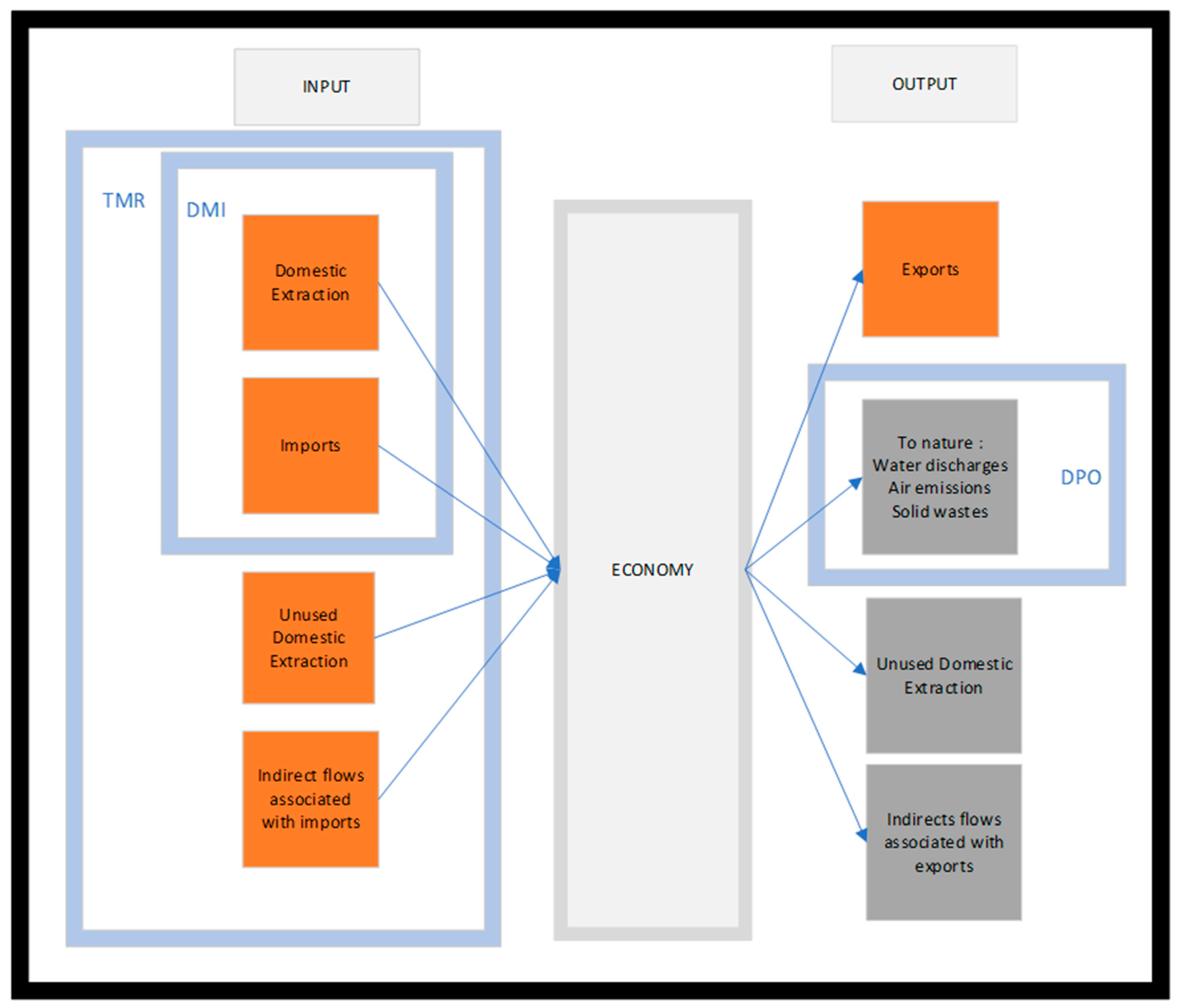
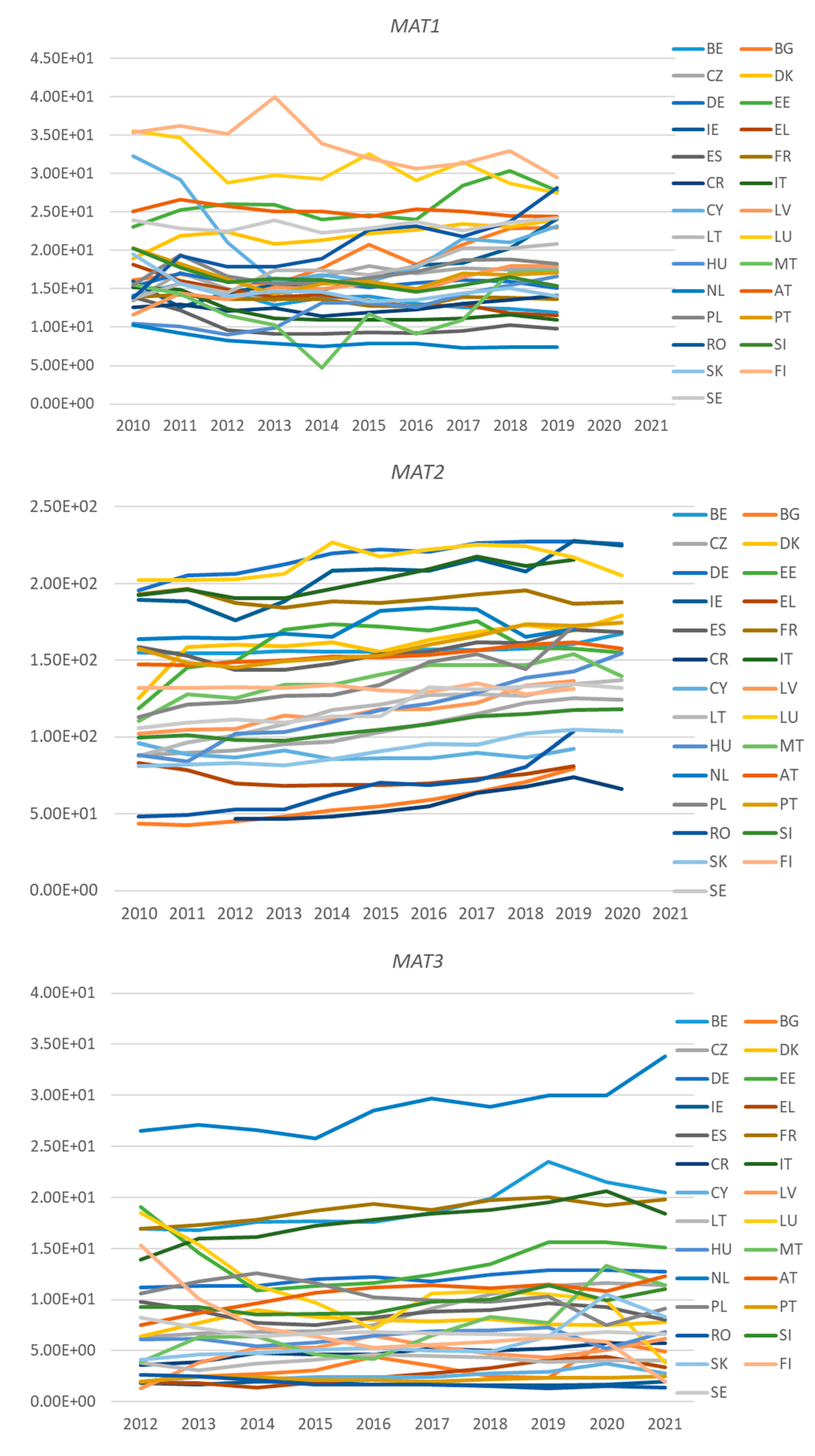


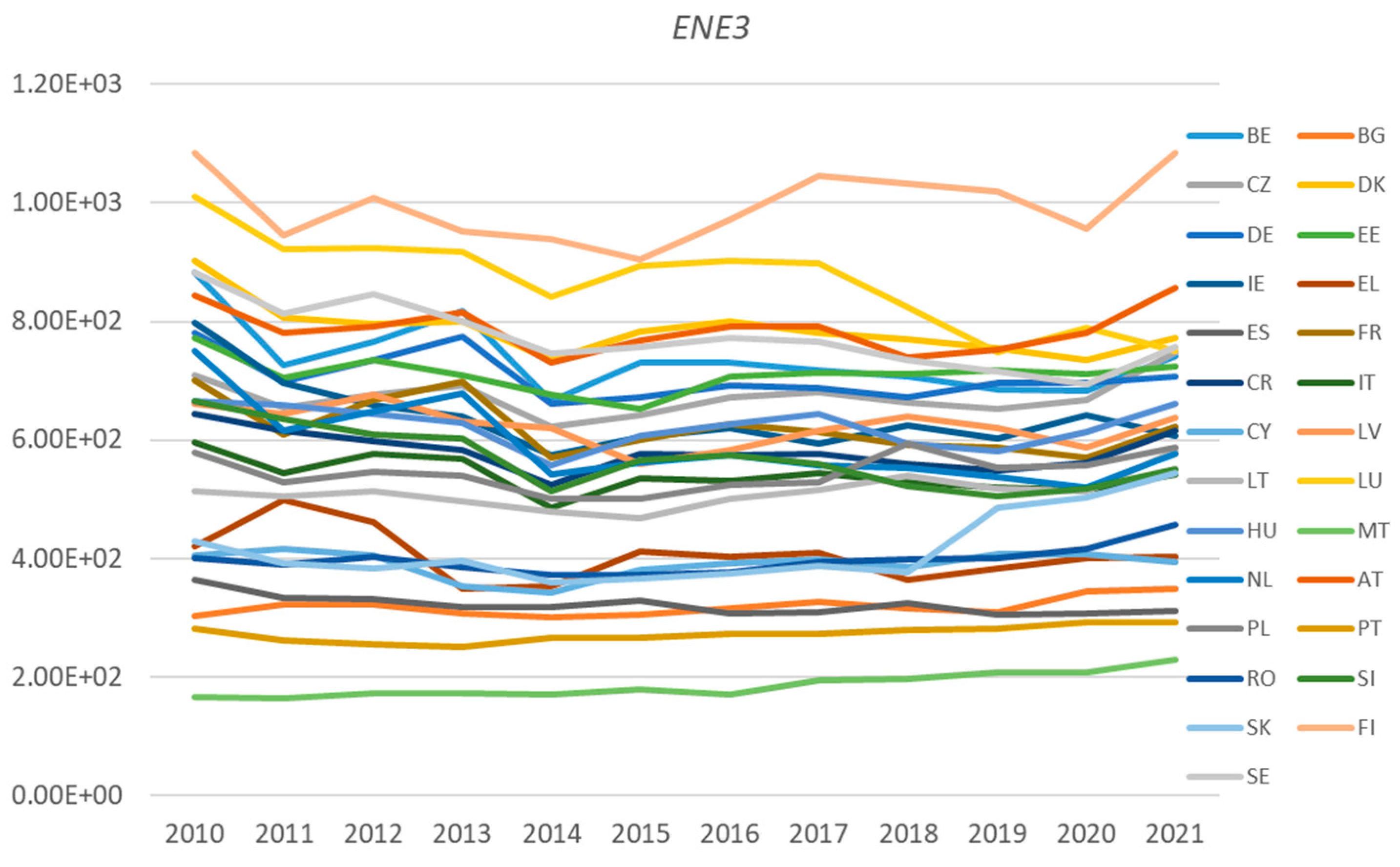




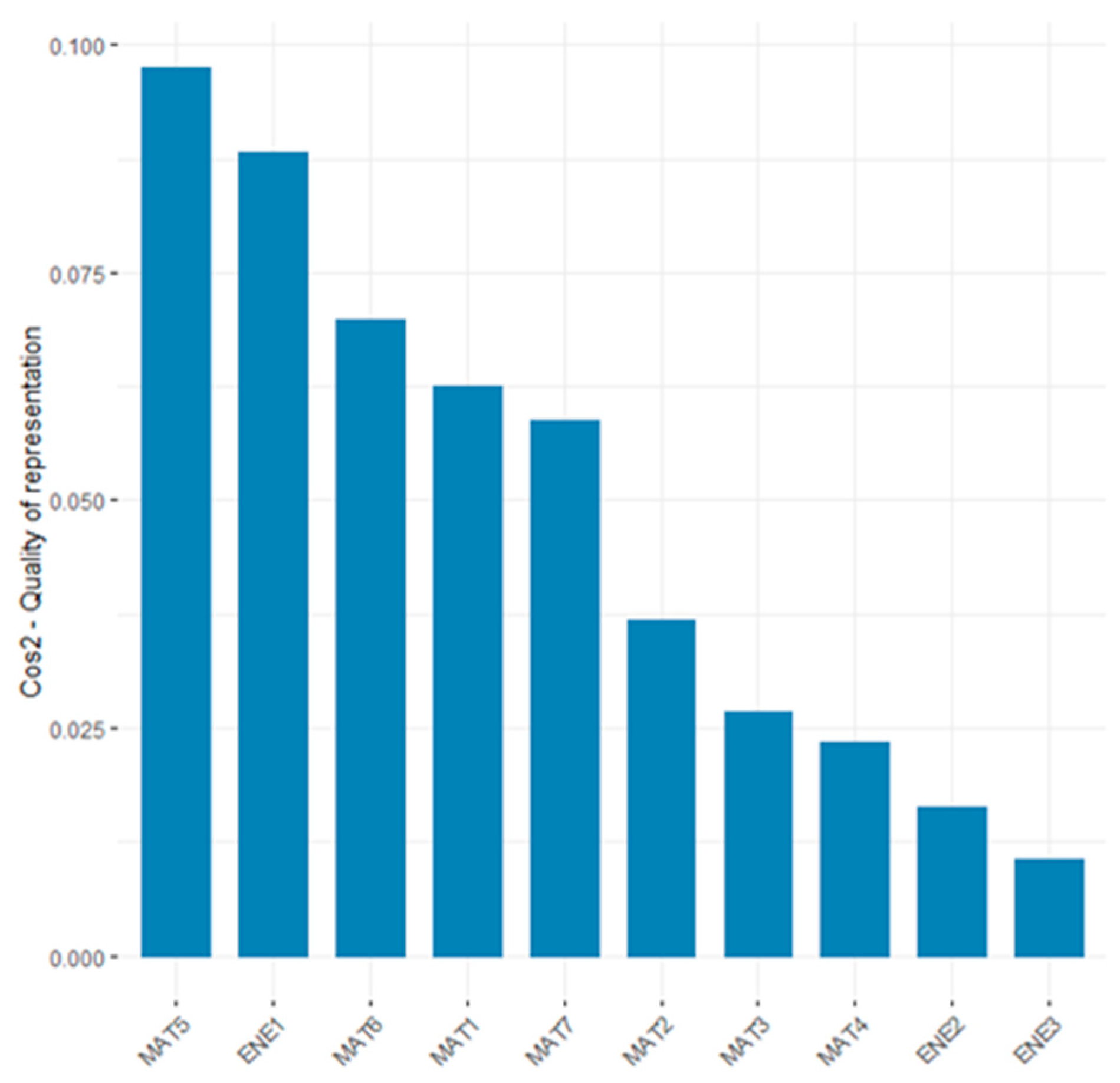
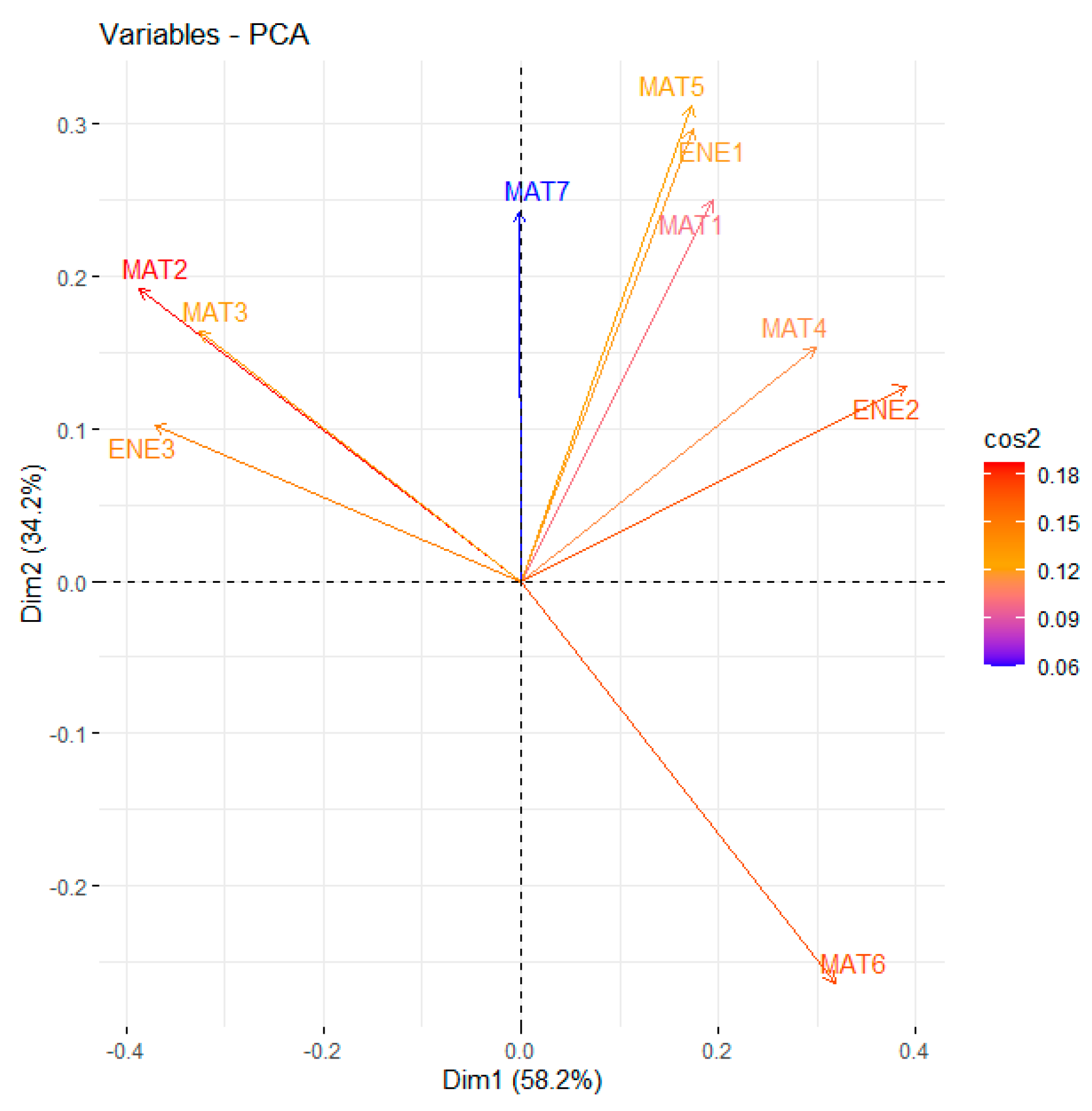

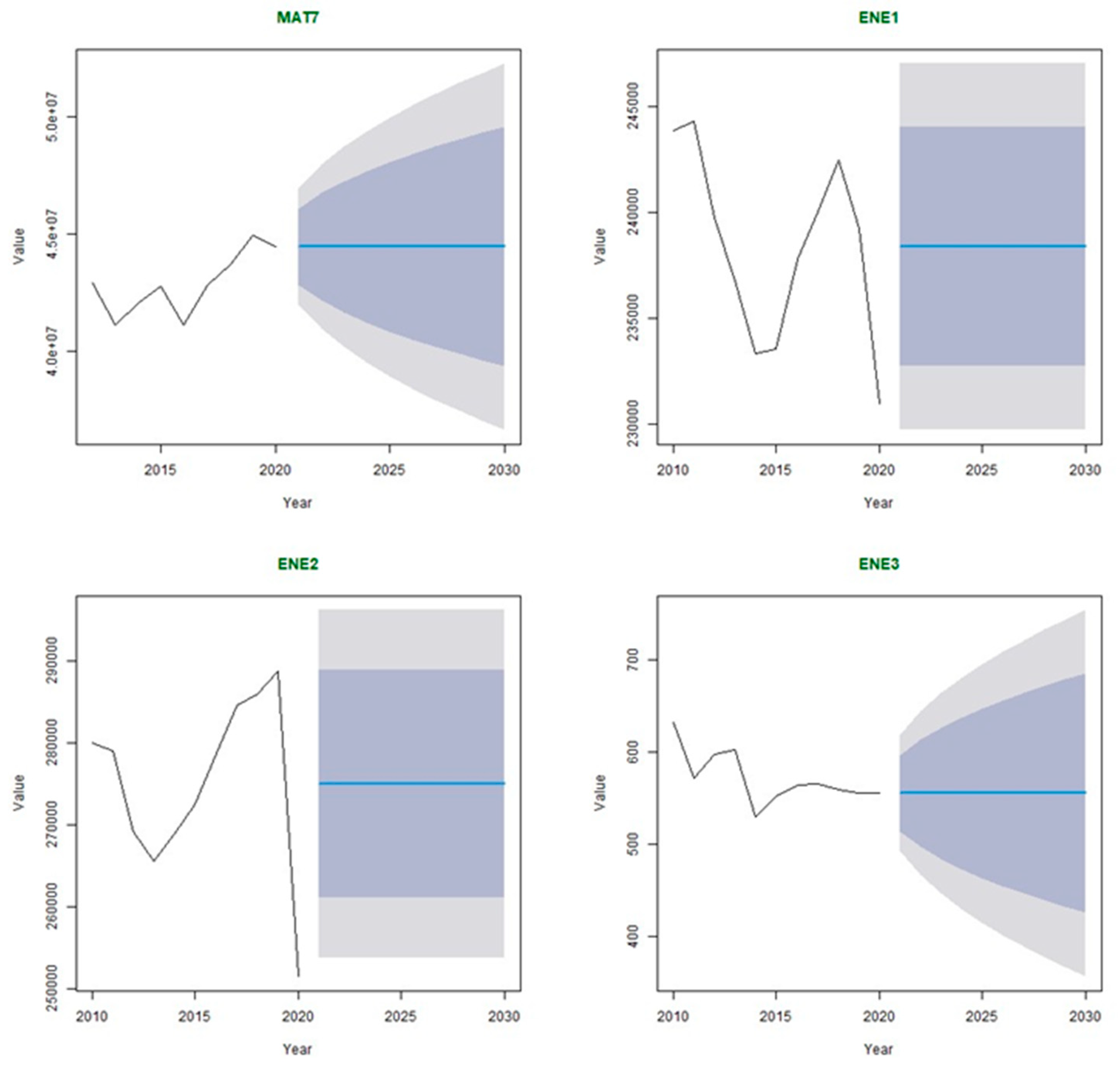
| Indicator | Name | Calculation |
|---|---|---|
| TMR | Total material requirements | Domestic extraction + domestic extraction not used + imports + indirect flows associated with imports |
| DMI | Direct material input | Domestic extraction + imports |
| DMC | Direct material consumption | Domestic extraction + imports − exports |
| DPO | Domestic processed output | Air emissions, water discharge, solid waste, dissipative uses, and losses |
| RMC | Raw material consumption/resource footprint | Domestic extraction + imports in RME − exports in RME |
| RP | Resource productivity | GDP/DMC |
| Variable | Abbrev. | Units |
|---|---|---|
| Raw material consumption | MAT1 | tonnes per capita |
| Waste generated | MAT2 | kilograms per capita |
| Circular material use rate | MAT3 | percentage |
| Domestic material consumption | MAT4 | tonnes per capita |
| Material import dependency: total | MAT5 | percentage |
| Generation of waste, by waste category | MAT6 | tonnes |
| Trade in recyclable raw materials | MAT7 | tonnes |
| Final energy consumption in industry | ENE1 | thousand tonnes of oil equivalent |
| Final energy consumption in transport sector | ENE2 | thousand tonnes of oil equivalent |
| Final energy consumption in households per capita | ENE3 | kilogram of oil equivalent (kgoe) per capita |
| N | Range | Minimum | Maximum | Mean | Standard Deviation | Variation Coefficient | |
|---|---|---|---|---|---|---|---|
| MAT1 | 11 | 1.83 | 13.65 | 15.48 | 14.30 | 0.50 | 0.035 |
| MAT2 | 11 | 24.04 | 154.00 | 178.04 | 165.47 | 9.23 | 0.056 |
| MAT3 | 9 | 0.90 | 11.10 | 12.00 | 11.48 | 0.29 | 0.025 |
| MAT4 | 9 | 0.66 | 13.52 | 14.18 | 13.80 | 0.26 | 0.019 |
| MAT5 | 9 | 2.10 | 22.40 | 24.50 | 23.69 | 0.74 | 0.031 |
| MAT6 | 6 | 1.90 × 108 | 2.15 × 109 | 2.34 × 109 | 2.24 × 109 | 6.23 × 107 | 0.028 |
| MAT7 | 9 | 3.90 × 106 | 4.11 × 107 | 4.50 × 107 | 4.29 × 107 | 1.37 × 106 | 0.032 |
| ENE1 | 11 | 1.30 × 104 | 2.31 × 105 | 2.44 × 105 | 2.38 × 105 | 4.32 × 103 | 0.018 |
| ENE2 | 11 | 3.80 × 104 | 2.51 × 105 | 2.89 × 105 | 2.75 × 105 | 1.11 × 104 | 0.040 |
| ENE3 | 11 | 103.00 | 529.00 | 632.00 | 571.09 | 28.68 | 0.050 |
| N | Skewness | Kurtosis | |||
|---|---|---|---|---|---|
| Statistic | Standard Error | Statistic | Standard Error | ||
| MAT1 | 11 | 1.347 | 0.661 | 2.425 | 1.279 |
| MAT2 | 11 | 0.097 | 0.661 | −1.777 | 1.279 |
| MAT3 | 9 | 0.533 | 0.717 | −0.280 | 1.400 |
| MAT4 | 9 | 0.652 | 0.717 | −1.315 | 1.400 |
| MAT5 | 9 | −0.574 | 0.717 | −0.975 | 1.400 |
| MAT6 | 6 | 0.313 | 0.845 | 1.496 | 1.741 |
| MAT7 | 9 | 0.156 | 0.717 | −0.854 | 1.400 |
| ENE1 | 11 | −0.340 | 0.661 | −0.826 | 1.279 |
| ENE2 | 11 | −0.861 | 0.661 | 0.735 | 1.279 |
| ENE3 | 11 | 0.936 | 0.661 | 0.863 | 1.279 |
| Correlation | Value Range | Bi-Variables |
|---|---|---|
| I. Strongly Positive | >0.7 | MAT1-MAT4 MAT1-MAT5 MAT1-MAT7 MAT1-ENE2 MAT2-MAT3 MAT3-ENE3 MAT4-MAT5 MAT4-MAT7 MAT4-ENE2 MAT5-MAT7 MAT5-ENE1 MAT5-ENE2 |
| II. Positive | <0.5 and <0.7 | MAT1-ENE1 MAT2-ENE3 MAT3-MAT7 MAT4-ENE1 MAT7-ENE2 MAT7-ENE3 ENE1-ENE2 |
| Component | Standard Deviation | Proportion of Variance | Cumulative Proportions |
|---|---|---|---|
| DIM 1 | 0.914 | 0.582 | 0.582 |
| DIM 2 | 0.701 | 0.342 | 0.925 |
| Variables | DIM 1 | DIM 2 |
|---|---|---|
| MAT1 | 0.213 | 0.357 |
| MAT2 | −0.424 | 0.274 |
| MAT3 | −0.357 | 0.233 |
| MAT4 | 0.327 | 0.219 |
| MAT5 | 0.190 | 0.446 |
| MAT6 | 0.349 | −0.377 |
| MAT7 | −0.001 | 0.346 |
| ENE1 | 0.191 | 0.424 |
| ENE2 | 0.427 | 0.183 |
| ENE3 | −0.406 | 0.147 |
Disclaimer/Publisher’s Note: The statements, opinions and data contained in all publications are solely those of the individual author(s) and contributor(s) and not of MDPI and/or the editor(s). MDPI and/or the editor(s) disclaim responsibility for any injury to people or property resulting from any ideas, methods, instructions or products referred to in the content. |
© 2024 by the authors. Licensee MDPI, Basel, Switzerland. This article is an open access article distributed under the terms and conditions of the Creative Commons Attribution (CC BY) license (https://creativecommons.org/licenses/by/4.0/).
Share and Cite
Martins, F.F.; Castro, H.; Smitková, M.; Felgueiras, C.; Caetano, N. Energy and Circular Economy: Nexus beyond Concepts. Sustainability 2024, 16, 1728. https://doi.org/10.3390/su16051728
Martins FF, Castro H, Smitková M, Felgueiras C, Caetano N. Energy and Circular Economy: Nexus beyond Concepts. Sustainability. 2024; 16(5):1728. https://doi.org/10.3390/su16051728
Chicago/Turabian StyleMartins, Florinda F., Hélio Castro, Miroslava Smitková, Carlos Felgueiras, and Nídia Caetano. 2024. "Energy and Circular Economy: Nexus beyond Concepts" Sustainability 16, no. 5: 1728. https://doi.org/10.3390/su16051728
APA StyleMartins, F. F., Castro, H., Smitková, M., Felgueiras, C., & Caetano, N. (2024). Energy and Circular Economy: Nexus beyond Concepts. Sustainability, 16(5), 1728. https://doi.org/10.3390/su16051728











